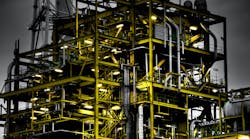Baker Hughes, whose software helps oil companies to optimize their operations, recently said that it would use graphics processing units from Nvidia to train deep learning algorithms that can predict when equipment might fail and improve the efficiency and reliability of expensive drilling and refining operations.
The announcement is further evidence that artificial intelligence techniques have invaded the software industry. Nvidia continues to dominate the market for chips with the power to train software on massive amounts of data, using the thousands of cores in its hardware to divide and conquer data amassed in industries from healthcare to internet search.
“Oil and gas companies are in the data business as much as they are in the hydrocarbon business,” said Mathew Binu, global head of digital products at Baker Hughes, which is majority owned by General Electric, in a statement. “To stay ahead of the competition, they need to derive insights from the massive amounts of sensor, geolocation, weather, drilling and seismic data they generate.”
The average offshore oil rig generates around 50 terabytes every year from sensors embedded in underground wells and machines to watch temperatures and pump pressure. It also stems from production measurements, equipment failures, and maintenance records. But lots of data is consigned to the digital equivalent of a mass grave, neither tagged nor analyzed.
Baker Hughes intends to use graphics processors to train deep learning algorithms on the reams of unstructured data from sensors and other sources. Baker Hughes will combine the deep learning models with physics algorithms that can model the operation of the oil platform. The hybrid software can then be used to predict the remaining life of equipment and how failures can affect systems.
Nvidia said that Baker Hughes would use its graphics processors to train algorithms in data centers and workstation that it can haul to offshore platforms where bandwidth is limited and data is generated. Then the software can be deployed to spot potential repairs or problems, environmental warnings, and more specific problems like corrosion.
On Thursday, Nvidia reported fourth quarter revenue of $2.91 billion, up from $2.17 billion in the same quarter a year ago. The company also said that its data center business earned $606 million in revenue, up from $296 million in fourth quarter last year. The company’s stock value has more than doubled since last January.

